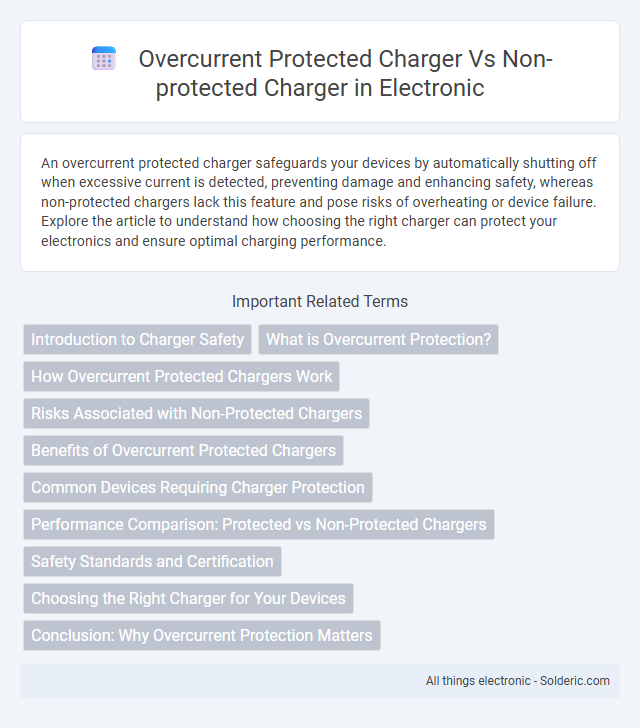An overcurrent protected charger safeguards your devices by automatically shutting off when excessive current is detected, preventing damage and enhancing safety, whereas non-protected chargers lack this feature and pose risks of overheating or device failure. Explore the article to understand how choosing the right charger can protect your electronics and ensure optimal charging performance.
Comparison Table
| Feature | Overcurrent Protected Charger | Non-Protected Charger |
|---|---|---|
| Safety | Prevents damage from excess current | No protection, risk of overheating and damage |
| Device Longevity | Extends device lifespan by avoiding electrical faults | May reduce device lifespan due to electrical stress |
| Cost | Higher price due to safety components | Lower cost, less complex design |
| Reliability | More reliable in fluctuating electrical conditions | Less reliable, prone to failure under overload |
| Usage | Recommended for sensitive and expensive devices | Suitable for basic or low-cost electronics |
Introduction to Charger Safety
Overcurrent protected chargers incorporate built-in circuits that prevent excessive current flow, reducing risks of overheating, fires, and damage to electronic devices. Non-protected chargers lack this safety feature, making them prone to short circuits and potential electrical hazards. Implementing overcurrent protection is crucial for ensuring reliable and safe charging performance in modern electronics.
What is Overcurrent Protection?
Overcurrent protection is a safety feature integrated into chargers to prevent excessive current flow that can damage electronic devices or cause overheating and potential fire hazards. Overcurrent protected chargers automatically detect and limit the current to safe levels, ensuring the device receives a stable and controlled power supply. Non-protected chargers lack this feature, increasing the risk of device damage, short circuits, and decreased battery lifespan due to uncontrolled current surges.
How Overcurrent Protected Chargers Work
Overcurrent protected chargers use built-in circuitry to monitor and regulate the current flow, automatically shutting off or limiting power when the current exceeds safe levels. This protection prevents damage to your device's battery and internal components by avoiding overheating and potential electrical faults. Non-protected chargers lack this safety feature, increasing the risk of device failure and safety hazards during power surges or short circuits.
Risks Associated with Non-Protected Chargers
Non-protected chargers lack built-in overcurrent protection, increasing the risk of overheating, short circuits, and potential damage to your electronic devices. Using a non-protected charger can lead to battery swelling, reduced lifespan, or even fire hazards due to uncontrolled current flow. Prioritizing an overcurrent protected charger ensures safer charging by automatically cutting off excess current, safeguarding both your devices and personal safety.
Benefits of Overcurrent Protected Chargers
Overcurrent protected chargers safeguard your devices by automatically shutting off the power flow when excessive current is detected, preventing potential damage and overheating. These chargers extend your device's lifespan by reducing the risk of electrical faults, making them a safer choice compared to non-protected chargers. Investing in an overcurrent protected charger ensures enhanced safety and reliability for your electronic devices.
Common Devices Requiring Charger Protection
Common devices requiring charger protection include smartphones, laptops, tablets, and other portable electronics that are sensitive to voltage fluctuations. Overcurrent protected chargers prevent damage from excessive current flow, ensuring the longevity and safety of your devices. Using a non-protected charger increases the risk of battery overheating, device malfunctions, and potential fire hazards.
Performance Comparison: Protected vs Non-Protected Chargers
Overcurrent protected chargers safeguard Your devices by automatically cutting off power during electrical surges, significantly reducing the risk of damage compared to non-protected chargers that lack this safety feature. Performance-wise, protected chargers may have a slightly higher initial cost and marginally slower charging speed due to built-in safety circuits but offer far superior reliability and device longevity. Choosing a protected charger enhances overall performance by ensuring stable current flow, preventing overheating, and maintaining consistent energy delivery.
Safety Standards and Certification
Overcurrent protected chargers comply with strict safety standards and certifications such as UL, CE, and FCC, ensuring reliable operation and reduced risk of electrical hazards. Non-protected chargers often lack these certifications, increasing the likelihood of device damage and potential safety risks like overheating or short circuits. Your choice of an overcurrent protected charger enhances overall electrical safety and safeguards connected devices.
Choosing the Right Charger for Your Devices
Overcurrent protected chargers prevent potential damage to your devices by automatically shutting off when electrical current exceeds safe levels, ensuring safe and reliable charging. Non-protected chargers lack this safety feature, increasing the risk of overheating, device malfunction, or battery damage. Choosing an overcurrent protected charger enhances device longevity and provides peace of mind during every charging session.
Conclusion: Why Overcurrent Protection Matters
Overcurrent protection in chargers safeguards your devices from excessive current flow, preventing potential damage and reducing fire hazards. Non-protected chargers lack this crucial safety feature, increasing the risk of overheating, short circuits, and permanent damage to your electronics. Choosing an overcurrent protected charger ensures long-term device reliability and safety for your investment.
Overcurrent protected charger vs non-protected charger Infographic

 solderic.com
solderic.com